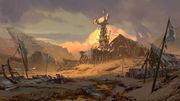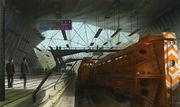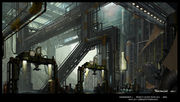Nancora Prime is a barren, terrestrial planet located in the Nancora system on the eastern edge of the Outer Rim. It is a small industrial planet with a surface scorched by a dying red star. Today it is one of the bases of the The Collective.
History
 Nancora from orbit
Nancora from orbit
Nancora, once a powerful industrial world, has turned barren over the last several millennia as its sun slowly shifted into its red giant phase. Once, during the time of the Old Republic, it was a world full known for its natural resources. A world of industrial complexes, huge cities, soaring skyscrapers and a booming population. However, as the centuries went on its sun had expanded rapidly, pushing the habitable zone with it and vaporizing what little surface water there remained on the planet. Plant and animal life crumbled and civilization eventually with it, its cities left abandoned and crumbling. Warm breeze turned to dust storms and pleasant sunshine into unbearable heat. Once filled with beautiful cities, the surface turned into a wasteland, forcing those survivors that could to leave while others built shelters underground.
During the years preceding the Clone Wars, the population, despite all odds, started to grow as the survivors developed ways to travel the surface. It took decades, but eventually they managed to build again, building factories to manufacture weapons, armor, droids and supplies for the Confederation of Independent Systems. Its growth exploded during the Clone Wars and soon after the empire. Trade returned bringing in much needed sustenance in exchange for labor and manufacture.
As the years went on, and the Empire’s grip waned, the power vacuum was filled by the large corporate sector. Off-world corporations, once working for the Empire and their massive war machine, began expanding their businesses and a cold and prolonged corporate war began which lasted for nearly a decade. In the end only one corporation remained, owning every factory and city on the planet. The Technocratic Guild made its breakthrough on Nancora some sixteen years before the destruction of Hosnian. They have ruled the planet and the accompanying system ever since.
Geography and climate
Nancora’s geography is comprised mostly of barren deserts, ruined cities, mountains and deep depressions that were once large lakes and seas. Many of the mountain ranges are filled with miles upon miles of tunnels that dot their sides and stretch across the landscape — all places where, formerly, people had lived.
Landmarks
The Nancorans eventually rebuilt their complexes and cities into five major centers: The main cities, Axio and Faron are large metropolises covering much of the planet's surface. Built around underground shelters over many years, they have grown beyond their meager limits and are clearly visible from space as large discs of concentric city blocks. A major railway system connects them across the barren wasteland in between. Much like the cities there are three major fabrication complexes on the ground. Donning the names 'Empusa', 'Chymera', and 'Hydra', these massive city-sized industrial complexes are split into fabrication blocks for many kinds of manufacturing facilities. Here the Nancorans manufacture and develop their weaponry, ships, equipment and supplies.
The rest of the planet is still filled with the ruins of ancient cities, metallic skyscrapers protruding from dust dunes and the remains of starships wrecked in too many wars. These ‘badlands’ are deathtraps for most people, places where dust storms play havoc on instruments, ships have trouble staying afloat and those lost often remain forgotten — it is also the place where the Technocratic elite train and prepare for their missions.
Faron City
 Faron City block
Faron City block
Faron is one of the twin cities on Nancora alongside Axio, breaking up the planet's scarred surface with their presence. Originally existing in the form of underground shelters, the city was built up slowly—layer by layer—until it became a metropolis so large that it can be clearly seen from orbit. In order to maintain an organized infrastructure, the city itself is separated into districts based on the disc-like, concentric blocks that make up its design.
The outer district is the largest of these. Here, the buildings form alleys and streets that criss-cross as they either run straight towards the center of Faron or curve along its circumference. The complexes found here are almost mathematical in design. Towers built upon towers, they all link together like geometric puzzle pieces with harsh lines and angles in lieu of softer edges. Having to deal with the elements, the durasteel constructs appear weathered and worn, but maintain a bright coloring to reflect as much light as possible and reduce its thermal conversion.
Industry thrives in Faron, and its districts embody this. In the outer district, shops meet with living centers and the lines between them blur. An apartment cluster appears much the same as a grand complex containing a myriad of speeders or other such technological constructions. Power relays, the key to keeping the city functioning in its entirely, are staggered along the streets and each level. Through redundancy, the system prevents the loss of a single relay from crippling it. The citizens flood the district at ground level, marching with haste towards their destinations while the skylanes flicker with activity high above.
In Faron's outer district, the thriving metropolis can be seen in all its many facets, but also at its most vulnerable.
The Badlands
 The Badlands
The Badlands
To walk upon the surface of Nancora is to take a path akin to a death sentence. That is how it earned its moniker: the Badlands. The Nancora system's star scorched the earth long ago, leaving a barren, sun-bleached surface behind. The soil remains as nothing but dust and left to the winds mercy. But there is none, as dust storms can form without warning and charge across the wastelands as roaring behemoths. The only shelter to be found lies scattered in the form of ruins of a time long past.
Spires and wreckage claw up through the cracked surface, giving the appearance of a planet-spanning junkyard. It is there that the Technocratic Guild gathers much of their resources, repurposing what once was into materials for new fabrications. At the same time, the most dangerous of these ruinous death-traps show the signs of the Technocratic elite's rigorous training. With a central spire rising from beneath a mound of wreckage, fresh scorch marks pocket the landscape of rising dunes in a circular clearing alongside the sand scraped remains of those who failed. A labyrinthian ring of partially unearthed structures closes in this area, providing some semblance of cover from the passing storms but nearly as dangerous themselves due to their weakened state. One wrong step can lead to collapse.
Very few come to the Badlands of Nancora. Fewer still make out out again.
Axio Transit Station Cresh
 Cresh station
Cresh station
On Nancora, the twin cities of Faron and Axio are connected via a single rail system. This direct line between them consists of staggered transit stations that provide a means of access to the badlands and the resources buried within them. Axio Transit Station Cresh is one such stop for the trams. Named as such due to its closer proximity to Axio than Faron, Station Cresh maintains the same design as all the other stations along the route.
The rail system itself spans four lines wide, double stacked to allow for maximum flow of transit. This results in eight active trams at any one time. Each side moves in the opposite direction of the other, meaning the fast moving trams could come rushing through at any time from either Faron, Axio, or both. The station itself consists of lifts and walkways leading to the surface far beneath the platform. The main buildings present offer up supply stalls serving food, beverages, and equipment, sold at a premium to account for their necessity in the Badlands. What remains is a small security presence as the Technocratic Guild has an armed garrison at each of their stations.
As a major supply route between the cities, the transit stations see a lot of traffic no matter the time. Station Cresh is one of the busiest, often seeing materials arriving from the lifts and being loaded onto the trams. The seeming small scale of the station can lend one to underestimating it, but its importance means any disruption will be dealt with swiftly.
Factory "Empusa"
 Empusa fabrication block
Empusa fabrication block
While not nearly as large as the twin cities on Nancora, the trio of factories that accompany them make a case to be called cities all their own. Empusa is the first of these industrial complexes, and the most notable. Its modular design lends itself to fabrication blocks entirely dedicated to specific needs. One section may be focused on the mass-production of firearms and other weapons, while another is producing vehicle after vehicle.
The largest of these fabrication blocks is also the most vulnerable, a cavernous bay resembling a dreadnought's hangar system with an opening leading directly to the land outside Empusa. It is here that fabricators line the floor, producing ground assault vehicles along a series of conveyors. Supplies and materials are stacked along the walls, ready for delivery to the waiting automated arms.
This section is overseen by a series of control rooms and interconnected catwalks that form a spider web suspended above the fabricators. Security is tight, each unit closed off to the others and ID locks at their entrances. Shield generators are built into the gaping maw of the fabricator bay, preventing the elements from entering the complex while allowing a staging area for the completed units